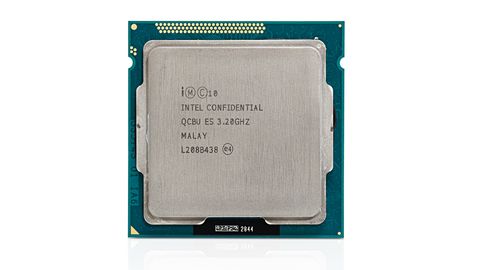TechRadar Verdict
Pros
- +
Decent performance
- +
Negligible drop-off due to lack of QuickSync
- +
Good auto OC via Turbo-boost
Cons
- -
No manual overclocking goodness
- -
Intel HD 2500 iGPU
- -
Not cheap enough
Why you can trust TechRadar
The big news about the first Ivy Bridge processors was the improved graphics, but with this second tier iGPU, can the Core i5 3470 match the pace of its technological compatriots?
With the i5 tag, it's a non-Hyperthreaded chip of the straight quad-core ilk, and sitting beneath the Intel Core i5 3570K means it comes with a lower starting clockspeed of 3.2GHz. The missing 'K' from its name shows up the lack of overclocking potential from the Ivy Bridge architecture.
That's a shame, as the other IvB chips we've played with have overclocked as well as their Sandy Bridge elders. But if overclocking's not your bag then grabbing a cheaper quad-core with the latest Intel architecture should be the sensible choice. Right?
Shader-light
If the Intel Core i5 3470 wasn't pared back enough (with the removal of Hyperthreading and overclocking for marketing reasons), consider that this Ivy Bridge CPU is also sporting the weaker of Intel's graphics parts.
In this chip we're looking at the Intel HD 2500 graphics versus the HD 4000 of the top Core i5 3570K and i7 3770K parts. That means a woeful six unified shaders compared with the generally inadequate 16 shaders of the HD 4000 core. If you're after the CPU graphics to deliver gaming performance, you'll be sorely disappointed.
While the HD 4000 does give some little hope of gaming frame rates - we were playing Batman: Arkham City at 1080p on the lowest settings at nearly 30fps - the slashing of constituent graphical components from the HD 2500 core means you've got little to no hope with it.
But you wouldn't expect processor graphics to offer gaming speed, and most of us are fully paid up members of the discrete graphics club. So what does it mean for the likes of QuickSync on this lower-end CPU?
The bad news is that there is some drop off in performance. The good news is that it's fairly negligible. Our MediaEspresso encoding benchmark took only 25s compared with the 23s for the HD 4000 series.
What about straight-line performance? At stock speeds it actually stands up against the i5 3570K, turbo-ing at 3.62GHz versus 3.82GHz. But that's where the K series chip's ease of overclocking comes to the fore. You can easily up the multiplier to 45-46 and hit crazy frequencies right away. The Intel Core i5 3470 though is limited to a multiplier of 38 for all cores, allowing it to go up to 40 for single core operation. That nominally means a limit of 3.8GHz.
Benchmarks
Rendering performance
Cinebench 11.5: Index score: Higher is better
INTEL CORE I5 3470: 6.01
INTEL CORE I5 3570K: 6.33
INTEL CORE I7 3770K: 7.91
Video encoding
Shogun: FPS: Higher is better
INTEL CORE I5 3470: 36.44
INTEL CORE I5 3570K: 38.46
INTEL CORE I7 3770K: 39.07
QuickSync performance
MediaEspresso: Time in seconds: Quicker is better
INTEL CORE I5 3470: 25
INTEL CORE I5 3570K: 23
That said, we managed to hit 3.99GHz with a little sprinkling of the baseclock overclocking that Ivy Bridge now allows. That sort of performance should make this chip a more compelling proposition.
It must be much cheaper, right? Well, there lies the rub. This chunk of hobbled silicon is barely £15 less than the awesome Intel Core i5 3570K. There is no reason we can think of to recommend anyone buy this chip over the top-end CPU. If you can't afford the extra £15, save for a couple weeks and just man up.

